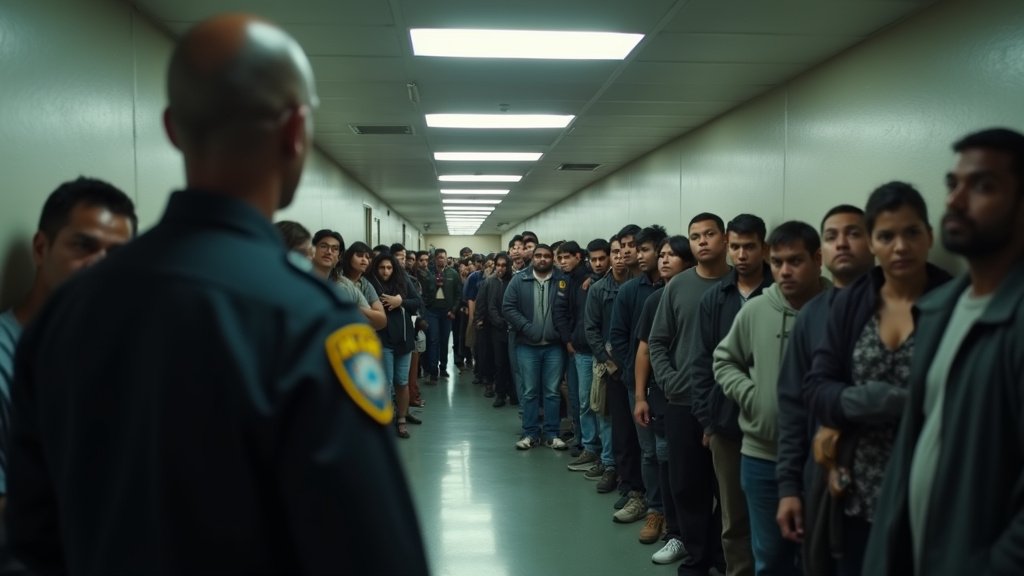The Nevada ICE Detainee Population has seen a significant upswing, with numbers at the state’s primary detention facilities climbing by more than 30 percent since September. This surge in the Nevada ICE Detainee Population is placing considerable strain on existing infrastructure and prompting discussions about potential expansions, according to recent data released by ICE. The unfolding situation highlights broader national trends in immigration enforcement and detention, including detention capacity issues.
Dramatic Increase in Nevada ICE Detainee Population
The latest figures reveal a stark increase in individuals held in ICE custody across Nevada. As of November 20, U.S. Immigration and Customs Enforcement (ICE) was holding an average of 554 individuals per day in its two Southern Nevada detention centers. This represents a substantial rise from September figures, with the Nevada Southern Detention Center in Pahrump alone seeing its population jump from 365 to 461 individuals. Similarly, the Henderson Detention Center reported an increase from 78 to 93 detainees during the same period. The changes are even more pronounced in Northern Nevada, where the Washoe County Jail has seen its ICE detainee numbers nearly triple, escalating from 16 to 46 individuals daily, marking an increase of nearly 200 percent. Statewide, the total number of individuals detained by ICE is approaching 600 per day, a significant jump over an eight-week span, impacting the overall Nevada ICE Detainee Population.
Overcrowding and Capacity Strain in Nevada
This rapid escalation in detainee numbers is exacerbating existing detention capacity issues, particularly at the Nevada Southern Detention Center (NSDC) in Pahrump. The facility, operated by CoreCivic, is one of the most consistently overcrowded ICE detention centers in the nation. While its overall capacity is over 1,000, and it holds detainees for various federal agencies, its contract with ICE is capped at 250 detainees per day. However, the center is now holding 461 ICE detainees, significantly exceeding this limit. Reports from April 2025 indicated it had already exceeded its contractual capacity by over 200 people. This persistent overcrowding raises concerns about the quality of care and access to legal representation for those detained, contributing to the strain on the Nevada ICE Detainee Population.
Plans for New Facilities and National Trends in Nevada
In response to growing demand, ICE is reportedly considering constructing a new “soft-side” facility, a temporary structure often composed of tents, at the Nevada Southern Detention Center. This proposed expansion could accommodate an additional 450 people, effectively doubling the detention capacity in Southern Nevada. This development aligns with a broader national initiative to increase ICE’s detention capacity, driven by increased funding and a stepped-up immigration enforcement Nevada agenda under the current administration. National figures show ICE detention populations reaching record highs, with over 66,000 individuals in custody nationwide as of early November 2025, a significant increase since January, further highlighting the pressures on the Nevada ICE Detainee Population.
Increased Enforcement and Shifting Focus in Nevada
The rise in detentions is closely linked to an increase in ICE arrests across Nevada. Through June 2025, ICE was averaging about 48 arrests per week in the state, more than four times the weekly average during the latter part of the previous administration. Notably, there has been a surge in arrests of individuals with no criminal record, a trend that runs counter to official statements focusing on deporting individuals with serious criminal histories. The passage of the “One Big Beautiful Bill” has further bolstered ICE’s operational capacity with substantial funding for detention expansion and hiring additional agents, signaling a sustained commitment to increased enforcement and impacting the Nevada ICE Detainee Population.
Advocacy Group Concerns Over Nevada ICE Detainee Population
Immigration advocates have expressed alarm over these developments. The American Civil Liberties Union (ACLU) has raised concerns about the expansion of private prison corporations in immigration detention, citing a history of abuses and inadequate oversight at facilities like NSDC. They warn that increased ICE presence could lead to family separations and erode community trust. Lawmakers have also voiced concerns, with the Nevada Latino Legislative Caucus reporting that detainees described experiences suggestive of racial profiling and questionable conduct by ICE officers. The growing detainee numbers also strain resources for legal aid, as reported by organizations like the UNLV Immigration Clinic, which faces an increasing caseload with limited pro bono attorneys, further complicating the situation for the Nevada ICE Detainee Population.
The current surge in ICE detainee numbers in Nevada underscores a period of intensified immigration enforcement. As facilities grapple with overcrowding and detention capacity issues, and plans for expansion are on the horizon, the implications for the Nevada ICE Detainee Population, communities, and the broader immigration system continue to be a significant focus of news and advocacy efforts.





